This CE Center article is no longer eligible for receiving credits.
A number of related trends in architectural design today are contributing to a growing use of Western Red Cedar (sometimes called “red cedar” or “western redcedar”), a wood species that can present a number of performance advantages. Yet, like many natural materials, the general classification Western Red Cedar comprises a large range of potential traits and application options. Various grades, colors, patterns, and cut techniques account for much of the variety in use and design expression.
One segment of the grades spectrum for Western Red Cedar is clear, which displays a relatively “limited number of natural characteristics” according to RealCedar.com.1 Clear grades are considered to be high-quality products, and for siding or trim, for example, they are normally supplied kiln-dried.
Contrasting with the clear variants is knotty cedar, also supplied kiln-dried, which offers more variety in visual characteristics and appearance and can be used to present a finish that is more textured and biomorphic. Described by designers as “smart casual,” “rustic,” and “optical,” knotty cedar grades are also available for some light structural applications. Dimensional sizes of Western Red Cedar for light framing and structural joists and planks are typically kiln-dried or unseasoned.
Consideration of the use of knotty cedar opens doors to new design expression for architects, including those who use clear grades of Western Red Cedar in other projects—or in the same buildings and interiors alongside the other grades. Recent examples include the downtown Seattle storefront of retailer Columbia Sportswear, designed by Boston's Bergmeyer Associates (with Raja Slate tiles), or the award-winning Lobster Boat Residence on Seattle's Portage Bay by Chadbourne + Doss Architects, with the latter displaying both exterior and interior applications. The knots—left by the base of a side branch or a dormant bud, yielding areas of hardened, darkened wood in roughly circular patterns around which the grain direction flows—can be exploited for a number of visual effects.

Photo courtesy of WRCLA
For students on the South Saanich Indian Reserve on Vancouver Island, an addition to Saanich Indian School Board (SISB) is clad in Western Red Cedar siding and trims with posts and landscape elements.
Grades as well as standards for the wood species are defined and promulgated by the National Lumber Grades Authority (NLGA), West Coast Lumber Inspection Bureau (WCLIB), and Western Wood Products Association (WWPA) in addition to WRCLA producer standards. Several are suitable for siding and trim, one of the most common architectural uses of Western Red Cedar, says Paul Mackie, a technical specialist and field representative for the lumber association. For example, bevel siding—the most widely used kind, in which the lumber is resawn at an angle to create a thicker edge and a more slender edge—is offered on the following categories:
▶ Clear Vertical Grain (VG) Heart. The highest grade for bevel siding, all clear VG heart grade is sawn vertical grain, also known as edge grain, and kiln dried. The smooth faces should be free from any “growth characteristics” that could impact performance or look, says Mackie, so they hold finishes well and exhibit the best dimensional stability.
▶ A Clear. This is also a fine grade meant for consistent appearance, though it allows more growth characteristics in pieces of mixed grain—both vertical and flat. They may be sold along with B grade pieces of cedar.
▶ Clear Rustic (also called Clear Tex). Where a more rustic or saw-textured appearance is desired, the rustic grade may be suitable, with its limited growth characteristics that offer a distinctive look but do not detract from serviceability.
Clear Vertical Grain and A Clear bevel siding are graded for smooth face applications but are generally also reversible to the resawn face.
On the other hand, some designs call for the special look of knotty Western Red Cedar, which adds warmth and impact as a bevel siding or trim product. The look is essential to the Lobster Boat House project, which blends the wood with reinforced acrylic sheets and fiber cement panels to “celebrate its location” on a dense urban shoreline site. In addition to reusing an existing floor and basement foundation, the building employs materials and systems “based on low monetary, environmental, and life-cycle costs.”
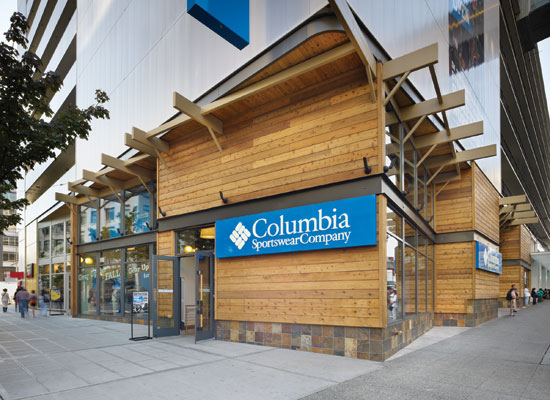
Photo by Benjamin Benschneider, courtesy of WRCLA
The signature retail spaces for Columbia Sportswear Company and subsidiary brand Mountain Hardwear created a storefront of knotty Western Red Cedar leading into nearly 20,000 square feet of retail space on a highly visible corner in Seattle.
In this way, knotty cedar has earned a reputation as a value specification, though it is seen in high-end building projects including country clubs, resorts, and high-visibility commercial settings. In these applications, two kinds of knotty grades are used for siding:
▶ Select Knotty. As expected, this grade has knots and other natural features, though the knots must be sound and tight. In occasional cases, the siding boards may be prepared with knots glued on the reverse face. It may also be sold with a percentage of Quality Knotty grade. (NLGA 205b/WCLIB 111-f)
▶ Architect Knotty. This product is designed for siding detailed with the resawn face exposed, after trimming, to fit the needed stud wall spacing or other substrate conditions. These boards have no open areas or through defects, and adhesives may be used, in a small number of cases, on the reverse face to secure knots. This is a good, kiln-dried grade for factory priming or finishing.
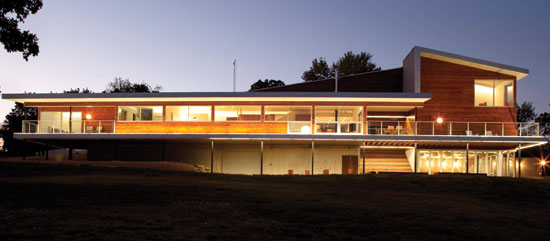
Photo by Hufft Projects and WRCLA
The architecture team at Hufft Projects specified sustainable Grade A clear and Select Knotty grades of Western Red Cedar and a monumental aluminum shed roof, all elevated on steel columns.
Other types of siding call for different grades and wood standards. For example, the vertically articulated board-and-batten claddings are typically made with rough-sawn, kiln-dried wood or boards surfaced on one side and two edges. On the other hand, lap sidings with shadow line effects, such as channel siding—whether installed vertically, horizontally, or diagonally—can use knotty grades including Select Knotty or A Clear-type pieces. Other siding profiles can be seasoned or unseasoned and can be clear or knotty grades, but in general, specialists will rarely recommend diagonally applied sidings. The claddings should be kiln-dried for best results. Lap siding types may also be specified as:
▶ Clear Heart, the highest grade for clear Western Red Cedar. This grade includes only pieces with heartwood on the exposed face. Some pieces may have minor imperfections, but overall the grade ensures a fine, consistent appearance.
Trim boards are another common architectural application, and grades and textures for Western Red Cedar boards have been developed to serve this niche, including both clear and knotty varieties.
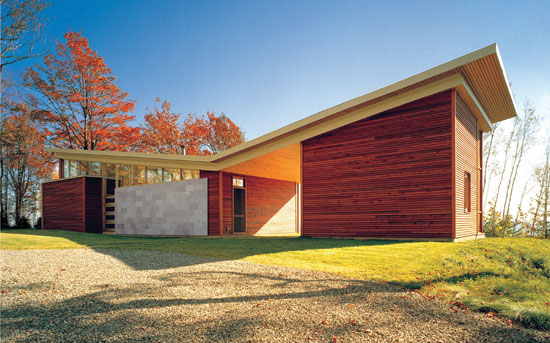
Photo by Marc Cramer, courtesy of WRCLA
Using a mix of stone, wood, and glass, the firm Affleck de la Riva Architects designed the Minton Hill House in Québec using knotty grades of Western Red Cedar.
Enhancing the design flexibility, the boards can be textured as rough, surfaced on one side, two edges and surfaced on four sides. If knotty is preferred, the best grades to choose are Select Knotty and other proprietary or in-house grades determined suitable by the producer. Where clear Western Red Cedar is desired for kiln-dried finish lumber, Clear Heart and A Clear grades are typically used. Two additional grades are available for trim made of unseasoned or seasoned clear grades:
▶ C and Better Clear. This is high-quality lumber for use where appearance is important, used both as trims and for cabinetry, doors, windows, and the like.
▶ D Clear. For general utility and cost savings, this grade may be allowed. It permits larger and more numerous natural visual characteristics. Cross-cutting may be necessary to achieve the best results for this grade.
For trim boards and for some kinds of siding, there are also proprietary grades—a term that means the wood is designed to meet the appearance requirements given by the architect and defined, agreed, and “graded” by the producer. In this case, the architect and project team should work with the manufacturer to understand the specifications written in terms of nomenclature and visual results.
Decking and Timbers
In some cases, Western Red Cedar decking is specified and designed by the architectural team, especially when part of a custom or commercial project. Two grades apply to decking, and a third knotty grade is specified for timbers:
▶ Architect Knotty. As with siding assemblies, this grade is specified for the best-quality, most visually consistent knotty timber, boards, or trims. The Architect Knotty standard, defined by WRCLA, requires sound and tight knots. Architect Knotty may not have any holes or wane on the graded face, which describes the presence of bark or lack of wood from any cause on edges or corners. Kiln-dried materials are well-suited to factory finishing.
▶ Custom Knotty. Defined to combine good looks and budgetary value, the Custom Knotty standard is applied only to decking. Unlike the Architect Knotty grade, the Custom Knotty grade limits holes and restricts wane and unsound knots to a lesser degree.
▶ Appearance Knotty. Used for timbers only and for both structural and nonstructural uses, Appearance Knotty grades of Western Red Cedar are manufactured to meet the visual requirements of quality projects, thus explaining its name. However it is known for value, not just appearance. No holes or other inappropriate characteristics are allowed, and wane allowances are highly restricted to ensure well-defined corners.
There are other standards for Western Red Cedar that architects may employ in project specifications, including the lower-cost Standard and Better category, used for general construction and other applications where structural benefit should outweigh the need for uniform, quality appearance. This contrasts with Select Knotty, the grade of product for trim boards with sound, tight knots and other natural features known for strong visual character and performance traits ideal for exterior and interior applications. In some cases, this grade may include a percentage of Quality Knotty grade.
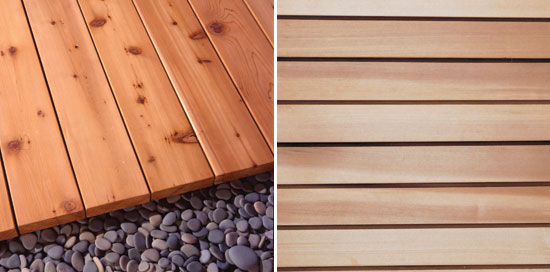
Photos courtesy of WRCLA
A close up of knotty and clear Western Red Cedar show how the visual characteristics of the two grades are quite distinct, adding texture and optical qualities to architectural applications.
For decking and similar applications, the knotty varieties contrast with the clear grades of Western Red Cedar, including Architect Clear, a WRCLA standard that requires the greatest possible, strictly controlled visual appearance. Whether seasoned or unseasoned, the products' fine appearance can be costly, and many projects require a custom order for the lot of specified material, rather than finding off-the-shelf availability. Alternatively, some decking and other applications may benefit from the Custom Clear grade of Western Red Cedar, which delivers the wood's stability and durability in a sophisticated clear appearance ideal for the most discriminating designers. Custom Clear requires a finely machined surface that shows limited characteristics that could detract from its visual attractiveness, making it a frequent specification for custom homes and nonresidential projects requiring fine woodwork.
Western Red Cedar is also widely used for large buildings in which “both the strength and appearance of exposed wood members are of equal importance; and second, in landscape, park, and garden structures where appearance is paramount,” according to WRCLA, which may include outbuildings, gazebos, and pergolas as well as classic exposed heavy-timber lodge buildings, residences, and commercial structures. In these cases, the naturally resilient qualities of the wood provide a lasting and weather-resistant construction of exposed timbers. For timber construction, the offered grades of clear Western Red Cedar include:
▶ No. 2 and Better Clear, for the finest-quality rough lumber.
▶ C and Better Clear and D and Better Clear, which offers good appearance in high-quality lumber suitable for architectural landscape structures and as exposed posts and beams in heavy timber construction. The grades may be mixed, and D Clear will have large and more numerous natural traits that are acceptable for outdoor structures. Cross-cutting may be necessary with lower grades of Clear to achieve the required results.
Appearance Knotty grades are also offered as a nonstructural component of timber and outdoor structures. In addition, there are three structural grades: Select structural, No. 1 Structural, and No. 2 Structural, which are evaluated for strength and stability and employed in engineered applications where appearance is not an important specification criterion. (Timbers may be ordered that meet both appearance and structural standards.) Similarly, Standard beams posts and timbers are like utility lumber or rough lumber, used for “general construction purposes where serviceability is more important than appearance.”
Benefits of the Wood Species
Yet it is often the appearance of fine grades of Western Red Cedar that lead to its wide use in innovative architectural statements. And with the wide range of grades available, it's no surprise that some architectural design teams have found ways to blend two or more grades for varied visual effect, special application needs and for sensible, cost-conscious product selection. In all the grades, however, there are performance traits endemic to Western Red Cedar that should be understood and exploited in building design.
Versatility and Workability. For both architecture/engineering firms and contractors, Western Red Cedar is easy to use. Compared to many wood species, both the clear and knotty grades are relatively low in density and high in material consistency, improving the ability of trades to cut, nail, and glue effectively—even with fine woodworking tools. The resulting pieces are highly durable and dimensionally stable: For example, the size differential between dry and unseasoned Western Red Cedar is about 1/16 inch for a nominal dimension of between 2 inches and 4 inches; the percent shrinkage is also very low, varying from 0.3 percent to 3.8 percent, depending on whether the wood is green or kiln-dried. It is one of the most stable species in North America.
Architects find they can apply a wider range of finishes and colors to Western Red Cedar because of the ability of this pitch-free, resin-free species to accept and maintain stains and finishes. Standard colors are just a start: effective applications range from lightly toned, clear solutions to two-coat solid colors.
Resistance to Decay and Insects. Though it is free of pitch and resins, Western Red Cedar is rich in natural extractives that boost durability. One of North America's more resilient wood species, Thuja Plicata cedar fibers contain thujaplicins, compounds that have natural preservative qualities, making the wood resistant to mold, insects, and decay and helping it last for decades when properly detailed and finished. (Some Pacific Northwest totem poles last for centuries, typically finished with natural pigments.2 See “Western Red Cedar: Material Attributes,” page 4.) While protecting buildings against deterioration even in coastal areas and harsh environments, the anti-fungal, anti-bacterial properties also give the wood its characteristic, memorable aroma.
Environmental Benefits. Maintenance requirements are also comparatively low for cedar building elements, which along with their durability helps to improve the green qualities of the design. There are other green considerations: According to the Minnesota Sustainable Housing Initiative (MSHI), common wood species used for siding include Western Red Cedar, redwood, cypress, Northern White Cedar, and Eastern white pine,3 which offer numerous environmental benefits. Starting with their renewable traits and also their forests, which support diverse ecological habitats, there are multiple green benefits. Western Red Cedar also “is energy-efficient to produce, very little waste is produced in its manufacture (since waste wood is often used for other manufactured wood products), and it is biodegradable,” adds the MSHI.
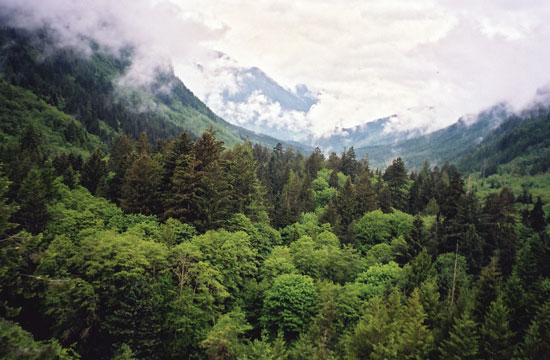
Photo courtesy of WRCLA
More than 85 percent of all forestlands producing Western Red Cedar in British Columbia are certified by SFI (Sustainable Forestry Initiative), CSA (Canadian Standards Association), or FSC (Forest Stewardship Council).
Yet the group also raises a sticky point: The benefits for the environment of specifying wood depend heavily on forestry management practices. Sustainable practices help limit soil erosion, maintain species diversity, and protect waterways, and provide habitat for wildlife. For this reason, architects with green building practices can specify from a broad array of forests independently certified to various third-party management standards, which in British Columbia account for about 85 percent of the material's supply.
There are other qualities inherent to the wood species that merit attention for green building. For example, Western Red Cedar may contribute to a lighter carbon footprint than alternatives because its low density can increase the R-value of cladding assemblies. Compared to masonry, vinyl siding, and fiber cement board, Western Red Cedar has been tested to demonstrate lower U-values, meaning it can insulate better and retain more heat or cold. Similarly, its acoustic performance compares well with other materials, providing a good sound transmission class (STC) because of its low density and good damping of vibrations. These are benefits both in envelope applications and as interior paneling. In addition, architects can design fire-resistant construction by specifying and detailing suitable Western Red Cedar shingle envelopes, according to Mark Rutledge, vice president of sales and marketing for producer Shakertown.
Last, Western Red Cedar can reduce the need for toxic chemical treatments. Alternatives such as pressure-treated woods have preservatives that are unnecessary for the thujaplicin-bearing species, making the latter ideal for schools and playground equipment.
Reduced Weight and High Strength. The characteristically large, open cell structure of Western Red Cedar gives it a distinct appearance but also makes it less dense than most other softwoods. Lighter in weight, the timbers and panels require less structural support and less energy for transport from the mill yard to the fabricator to the job site. Yet in spite of the low density, Western Red Cedar is naturally strong, durable and dimensionally stable.
Western Red Cedar timbers make for excellent structural members. Depending on their size, they may be classified as posts and timbers or beams and stringers. The latter are rectangular in section, either surfaced or just rough sawn, in pieces measuring 5 inches and thicker with widths of at least 2 inches greater the width. Posts and timbers, on the other hand, are generally square members of a minimum 5 inches by 5 inches and larger, though widths that may be up to 2 inches greater than the thickness, though not more.
Aesthetic Range. Among the favored attributes of high-quality finish wood is its ability to lay flat and remain straight. This stability and resistance to warp ensures both a crisp, finished look in the wood assemblies as well as a long-term durability for the building. According to experts in wood species, Western Red Cedar has an even grain and relatively consistent density—two qualities that reduce the undesirable tendencies to swell, cup or twist, which are common issues for many softwoods and hardwoods. Sources including The Wood Database provide specifics on such variables as Janka hardness, elastic modulus, and shrinkage; the latter is given as radial (2.4 percent), tangential (5.0 percent), and volumetric (6.8 percent) for Western Red Cedar.4
In addition, the availability described above of both the knotty and clear standards of good architectural performance allow architects to mix and match the grades to achieve varied aesthetics while holding the cost-benefit ratio within necessary bounds. For varied budgets, the Western Red Cedar palette provides a range of expression without the pitch and resin found in many softwoods. And though the wood is rich in extractives that enhance durability, the lack of pitch and resin improve the ability of Western Red Cedar to maintain a wide range of finishes, from lightly toned clear solutions to two-coat solid colors.
Like any wood, the natural luster, graining and knot patterns provide a warm and often comforting aspect to a building or interior. The grain and knots can enhance the benefit to building occupants of biophilia, a notion advanced by Harvard biologist E. O. Wilson in his 1984 book about the “instinctive bond” between human beings and other living systems that has been shown to have various positive effects on personal experience and health. As decking, wood provides natural spring and bounce that some synthetics and composite boards may lack. Western Red Cedar also has a subtle, natural aroma that is “another hallmark of its universal appeal,” according to WRCLA.
For many centuries, wood carvers and artists—as well as finish carpentry trades—have gravitated to Thuja Plicata for its positive qualities. With the benefits listed above, it's not surprising that some architects include the Latin name for Western Red Cedar in specifications to ensure the species is not conflated with other wood products, some bearing the name “cedar.”
Architectural Specs for Western Red Cedar
In addition to Latin namedropping with Thuja Plicata, there are a number of other practices that are recommended to maintain proper specifications and instruct contractors on proper delivery, storage, assembly, and sequencing of construction using Western Red Cedar. To take advantage of these varied benefits and the many grades of knotty and clear Western Red Cedar, seasoned architects pay attention to the key specifications and detail notations recommended by producers and consultants. According to the WRCLA, there are 27 expert producers of Western Red Cedar lumber products, all in British Columbia, Washington, Oregon, and Idaho, who can provide project guidance and specification advice. In addition, there are specifier service programs and cedar application specialists in Seattle, Washington and the Minneapolis-St. Paul area of Minnesota.
Advice for specifiers tends to begin with type of application, drilling down to suitable wood grades, nominal sizes, proper moisture content, exposed surface and joint or connection details, such as fasteners.
Siding and trim. “It's best to use dry, acclimatized cedar, typically kiln-dried, for siding and trim,” says WRCLA's Paul Mackie. “Boards should be pre-stained or pre-primed on all six sides prior to installation.” For all siding types, Mackie suggests including a grading rule or grading agency paragraph citation with the specification—such as “NLGA 201a” or “WCLIB 106-a”—if the product is required to meet that specific written standard. The architect may also want to undertake a coverage calculation for project budgeting or as a construction administration (CA) phase takeoff. Assistance with coverage calculation variables, such as trim allowance percentages, is available in producer literature and from forestry industry groups.
Architects and other project designers should also note industry experts strongly recommend the use of high-quality, stainless steel fasteners for all exterior applications. “Western Red Cedar is primarily used outside,” says Mackie, “so fasteners have to be corrosion-resistant, such as stainless steel, which is the best choice.” He and other experienced wood-design professionals add that double-hot-dipped galvanized iron and steel work as an alternative, but the materials must meet the standard ASTM A153, Standard Specification for Zinc Coating (Hot-Dip) on Iron and Steel Hardware. Lesser classes of galvanized steel materials are likely to create streaking, but tensile-strength aluminum will also work well. “Iron fasteners can leave ugly black streaks on the wood, and the natural preservatives in the wood will damage copper,” adds Mackie, noting that stainless-steel fasteners should be specified as marine grade (316) for projects on or near sources of salt water.
For Western Red Cedar exterior siding, the aesthetic and design options are quite varied and worth careful consideration in the design development (DD) phase. “It's an extremely versatile product that offers many design choices for residential, commercial, and institutional structures, including single and multi-family homes, office buildings, retail, churches, band shells, hotels, and historic buildings,” says Lynne Christensen, MBA, CAE, director of operations with the Cedar Shake and Shingle Bureau. However, she cautions that they must be “specified and installed correctly.” Following is basic advice from the book, How to Specify Western Red Cedar:
▶ Layered bevel. Among the most widely specified cedar siding type, layered-bevel siding is a traditional look but can take on a contemporary feel in some settings.
Specifiers should indicate the nominal size, grade, moisture content (kiln-dried) and the surface to be exposed (smooth or resawn). Clear cedar is available in plain bevel, rabbetted bevel and wavy edge. Specification of knotty grades must include a choice of the type of bevel—again, plain, rabbetted, or wavy edge. Note also that some suppliers of Select Knotty grade will glue knots on the reverse face. The quantity of siding required is usually expressed in surface measure rather than number of members or the like.
▶ Tongue and groove. In addition to nominal size, grade, grading paragraph, moisture content, and exposed surface, the specifications for tongue-and-groove siding should indicate a product pattern.
Common patterns include EV2S, with a V-joint on two sides, as well as EV1S, with a V-joint on one side. The S2S flush joint pattern is also commonly selected, but there are many other patterns produced in addition to these three typical designs. The specifier must be sure of the desired look and the pattern that will achieve it. In the case of tongue-and-groove siding, quantity should be expressed in board feet.
▶ Lap siding. Channel siding, one type of lap siding, can be installed vertically, horizontally, and even diagonally.
The typical specs from the above siding types apply, but the specifier should note that lap siding is available unseasoned or seasoned (kiln-dried). As with tongue-and-groove, the quantity should be expressed in board feet.
▶ Board & batten. Designers can specify almost any desired size for this vertical siding type, though a typical composition is 1-inch-by-10-inch boards and 1-inch-by-3-inch battens. Quantities for these cladding systems should be expressed in linear feet or board feet. Boards are available in clear or knotty, green or seasoned, rough-sawn or surfaced on a side and two edges, with the latter called S1S2E.
▶ Trim boards. Expressing quantity in linear feet, the designer chooses from corner boards, fascia, skirting, and fenestration detail, and specifies a finish that is smooth on four sides (S4S), surfaced one side and two edges (S1S2E), or rough sawn on all sides (rough). As with siding, all specs such as nominal size, grade, grading rule paragraph, moisture content, etc., must be included.
Applying proper specifications to the project will help ensure that producer estimates and takeoffs are as close to the actual project needs as possible. It also helps to reduce delays in project construction and also callbacks due to poor craftsmanship. However like any other materials and systems, there are complications and questions, and a knowledgeable trade leader or representatives of the WRCLA will be able to offer model specification language and, in some cases, typical detail drawings.
Decking. Producers offer decking products in one of four agreed-upon decking grade categories: Architect Clear, Architect Knotty, Custom Clear, and Custom Knotty. This system for decking product grades is intended to simplify the process of specification regardless of preferred style and budget. Architects or contractors must include this grade spec along with size, moisture content and quantity (in linear feet). Specifiers should be aware that decking quantity must be determined in part by including spacing, typically 1/8-inch clear width, between planks and between the ends of boards.
Tables are available from engineers, carpentry subcontractors, the WRCLA and some producers to assist in calculations. The spacing is crucial for proper drainage and drying, as this will extend the like of the deck. Also, clients should be advised on proper maintenance. Debris and moisture collection can cause damage over time.
Timbers. Western Red Cedar timbers typically are left exposed to display their inherent beauty. Projects where they will be seen include commercial, institutional and residential projects in which timber strength and appearance are both deemed important, and also landscaping structures for parks, gardens and similar outdoor spaces.
Available in air-dried or unseasoned clear and knotty grades, timbers are rectangular beams-and-stringer elements or square post-and-timber structures. Timbers are specified Surfaced Four Sides (S4S), rough sawn, or rougher headed. Specs should include size, grade, grading paragraph, moisture content and quantity in linear feet.
Fencing. Specifications for fencing must include details for posts (vertical), rails (horizontal), and infill material to be attached to the rails, unless prefabricated fencing sections are to be used. Top boards are available in pointed, dog-eared, Gothic and spearhead patterns, among others. Lattice can be specified for a lighter, open appearance.
Fence and gate hardware should be rust and corrosion-resistant. Popular hardware options include 4-inch x 4-inch metal post supports set atop fins that are driven in-ground, which eliminate post-hole digging. Aluminum or galvanized metal brackets resembling joist hangers can be used to secure rails to posts and to simplify corner attachments. Pattern, size, grade and grading paragraph should be included in specs, with quantity expressed as number of posts/length in feet; for example, 24/8 feet. Moisture content is typically not called out when specifying fencing.
Specifying Siding for Sustainability
Knowing that Western Red Cedar is a renewable resource from sustainably managed forests, there is much to recommend the wood for use in the U.S. Green Building Council's LEED certification programs and others such as Living Buildings and Green Globes, among others. The environmental benefits are many but especially so in the Pacific Northwest and anywhere that Western Red Cedar can be locally sourced.
What some designers and specifiers may not know is that there is significant documentation available for Western Red Cedar siding. For example, life-cycle analyses (LCAs) have been commissioned to compare siding made of Western Red Cedar side by side with alternatives. The studies produced remarkable results: Western Red Cedar's life-cycle performance shown to have preferable environmental impact in five out of seven metrics when compared to brick, vinyl and fiber cement. “Western Red Cedar decking 'slew the dragon,' beating virgin vinyl and plastic composite in all seven metrics,” says Mackie. “And Western Red Cedar siding outperformed in five categories.” Because wood products have some emissions from finishing and refinishing processes, that was one area where it ranked behind other siding products. However architects active in wood design note that many low-emissions finishes are available that perform well.
The WRCLA has also issued one of the very few environmental product declarations (EPDs) for siding products. The EPD documentation covered the system 1/2-inch x 6-inch bevel siding. The group embraced this type of transparency early, producing two of the handful of peer-reviewed EPDs that have been available in recent years. “Determining the true cost of materials requires evaluating the overall costs of a product lifecycle,” said WRCLA's executive director Jack Draper of the study. “Our EPDs provide buyers of Western Red Cedar from member companies with accurate, verifiable environmental performance information.”5
C.C. Sullivan is a marketing consultant and content studio specializing in the architectural industries and AEC firms (www.ccsullivan.com).
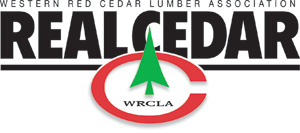 |
The Western Red Cedar Lumber Association is a Vancouver-based non-profit association representing 17 quality suppliers of Western Red Cedar lumber products in Washington, Oregon, and British Columbia (Canada). Founded in 1954 and known as “the voice of the cedar industry,” the WRCLA delivers market programs throughout the United States and Canada to support its members’ cedar products with information, education, and quality standards. RealCedar.com. |















